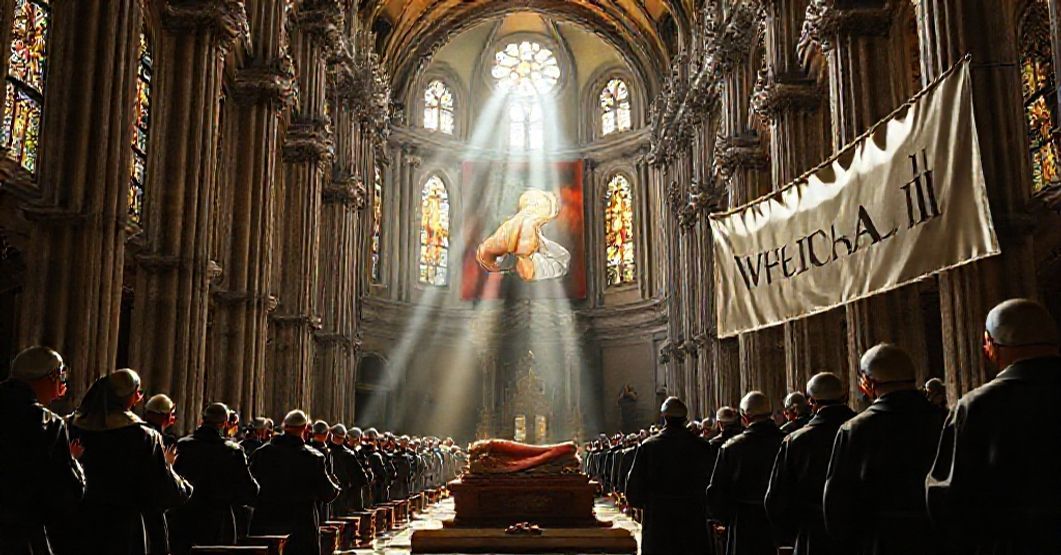Antipopes of the Antichurch



















Timeline of this heretical pontiff
Encyclical Letters
+ 15 posts1959
+ 7 posts1961
+ 4 posts1962
+ 2 posts1963
+ 2 postsApostolic Exhortations
+ 3 postsApostolic Constitutions
+ 93 posts1958
+ 6 posts1959
+ 87 postsMotu Proprio
+ 15 posts1958
+ 1 posts1959
+ 1 posts1962
+ 11 postsApostolic Letters
+ 151 posts1958
+ 4 posts1959
+ 63 posts1960
+ 78 posts1961
+ 1 posts1962
+ 4 posts1963
+ 1 postsSpeeches
+ 99 posts1958
+ 2 posts1959
+ 26 posts1960
+ 29 posts1961
+ 16 posts1962
+ 24 postsMessages
+ 6 posts1959
+ 4 postsHomilies
+ 4 postsLetters
+ 152 posts1958
+ 1 posts1959
+ 48 posts1960
+ 32 posts1961
+ 31 posts1962
+ 30 posts1963
+ 10 postsNot categorized
+ 1 posts1958
+ 1 postsNews feed


A A A ES – LA IOANNES PP. XXIII AD BASILIUM HEISER (1963.01.16)
The document is a Latin letter of the antipope John XXIII to Basil Heiser, Minister General of the Conventual Franciscans, on the 700th anniversary of the translation of the relics of St. Anthony of Padua, praising Anthony’s sanctity, eloquence, charity, connection with the Fourth Lateran Council, and exhorting the Franciscan family to prayer, preaching, charity, and fidelity to the aims of the so‑called Second Vatican Council. It wraps authentic Catholic symbols and a true saint in sentimental rhetoric to sanctify the neo-church’s conciliar revolution and to bend the memory of St. Anthony into an advance guard for Vatican II’s anthropocentric, naturalistic project.


Mirabilis ille (1963.01.06)
John XXIII’s letter “Mirabilis ille,” dated January 6, 1963, is a circular addressed “to all bishops of the Catholic Church and the other Fathers of the Second Vatican Ecumenical Council,” presenting the first session of Vatican II as a “wonderful” episcopal gathering, outlining the intersession work (January–September 1963), and exhorting bishops, clergy, laity, and even non-Catholic observers to collaborate spiritually, intellectually, and pastorally so that the Council might bear fruit for the Church and for the entire human family. It glorifies the conciliar process, emphasizes worldwide expectations, invites separated communities to watch with confidence, and projects Vatican II as an event ordered to peace, dialogue, and a broad, outward-facing aggiornamento of ecclesial life. In one sentence: this letter is the soft-toned but deadly ideological charter of a paramasonic, anthropocentric “council,” designed to dissolve the Catholic Church’s supernatural identity into a global, humanist project under the mask of pastoral optimism.


A A A LA Ioannes XXIII epistula ad Iosephum Pizzardo (1962.12.12)
This brief Latin letter from John XXIII congratulates Joseph Pizzardo on the completion of twenty-five years as a member of the College of “cardinals,” praising his bureaucratic service in the Roman Curia, his role in so-called Catholic Action, and his governance of seminaries and universities, concluding with the bestowal of an “Apostolic Blessing.” It is a perfectly distilled emblem of the self-referential, naturalistic, human-centered apparatus that was already displacing the Catholic Church from within before the council’s catastrophe erupted in full view.


Septingenti et quinquaginta (1962.11.29)
The Latin letter attributed to John XXIII, addressed to Michael of Jesus, General Moderator of the Order of the Most Holy Trinity for the Redemption of Captives, marks the 750th anniversary of the death of St. John de Matha. It praises the Trinitarian founder’s charity, recalls the heroic mission of redeeming captives from infidels, commends the historical fruits of the Order, and exhorts its members to imitate their predecessors in holiness and apostolic zeal in changing times, concluding with an “Apostolic Blessing.” This apparently pious tribute, however, functions as a polished facade: beneath its devotional varnish it silently confirms the authority of an intruder, empties authentic Catholic militancy of its doctrinal content, and instrumentalizes a truly Catholic saint to buttress the conciliar revolution in statu nascendi.
Varia
Announcement:
– News feed –implemented
– Antipopes separate web sites with their all documents refutation – in progress
